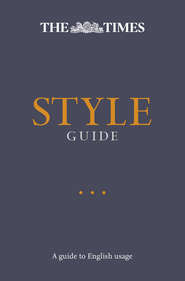скачать книгу бесплатно
Keith Waterhouse, as so often, had sound advice: “It is not the function of the comma to help a wheezing sentence get its breath back. That, however, is how the comma earns much of its living in journalism.” If your sentence needs a comma just to stop the reader collapsing in a heap before reaching the end, you might do better to recast it as two sentences anyway.
There is often no need for a comma after an adverbial formation at the beginning of a sentence: “Last week we were told etc”, “Until now there has been no need etc”, “In opposition the Lib Dems said etc”, “Minutes later the announcement was made”.
Avoid the so-called Oxford comma; write “he ate bread, butter and jam” rather than “he ate bread, butter, and jam”, except where to do so might create nonsense or confusion: “For lunch they had lamb with roast potatoes, and chocolate mousse.”
Commas with names and descriptions may help to indicate number. If “he was accompanied by his brother John” suggests that he has other brothers who did not accompany him, then “he was accompanied by his brother, John” makes clear that John is the only brother he has. With brothers the distinction may seem too subtle to bother about; it is worth bearing in mind when naming someone’s wife.
There is no need to put a comma between adjectives that form a kind of unit or where the last adjective is in closer relation to the noun than the preceding one(s), eg fine dry evenings, a good little boy.
Keep commas where they should be logically in “broken” sentences. Thus, the comma goes outside in the following example: “The trouble is”, he said, “that this is a contentious issue”
Commission when named: the European Commission, the Competition Commission; lower case in other refs
commissioner of the Metropolitan Police
commit do not use as an intransitive verb without a direct object, eg “he wants to commit to the reforms”; write “he wants to commit himself to the reforms” or “he wants to make a commitment to the reforms”
committee on standards in public life examines standards of conduct of all holders of public office. It is different from the select committee on standards and privileges, which deals with the conduct of MPs (subsequent mentions, the privileges select committee or lower case the committee)
committees are generally lower case but note 1922 Committee (cap) of Tory backbenchers, as it looks odd lower case. Cabinet and select committees should be lower case
common agricultural policy lower case, abbreviated as CAP for clarity; similarly, common fisheries policy (CFP)
common market usually use EU or EC (see Europe), although common market is acceptable in its historical context
common sense (noun), but commonsense, commonsensical (adjective)
common serjeant lower case. Note j spelling
Commons (keep cap) takes singular verb, eg “the Commons is debating …”
Commons fees office lower case. At subsequent mention the fees office for the place where decisions are made about whether to reimburse members’ expenses for moats and beams
Commonwealth heads of government meeting lower case after cap C
communiqué
communism, communist as with socialism and socialist, the best rule of thumb is to cap only when in specific party context, eg a Communist candidate, a Communist rally, the Communist mayor of Lille; but communist ideology, communist countries etc. Likewise fascist. It will help to think of a parallel with conservative/conservatism or liberal/liberalism. But Marxist, Stalinist and Nazi should be capped
community beware overuse in phrases such as the international community, the black community etc
companies there was once a useful distinction to be made between company and firm; the latter implied a business partnership, as in the legal or accountancy professions, estate agents etc. The words now seem to be used more or less interchangeably to cover almost any sort of enterprise, not least because the shorter word has obvious advantages for headlines
company names and brand names Follow the style and spelling that the company prefers unless it is ugly, distracting or absurd; use common sense. In practice, given the irritating prevalence of initial minuscules and mid-word caps in the modern corporate world, this will mean applying conventional orthography to many names that the companies themselves choose to write differently. So, use all caps only if a name consists of (and is pronounced as) a series of initials: BMW, IBM, EDF etc. Otherwise generally (and if in doubt) use an initial cap followed by lower case as for any other name, even if corporate branding is all upper or lower case or has capitals in odd places: Adidas (not adidas), Amazon (not amazon), Ikea (not IKEA), Easyjet, (not easyJet), Moneysupermarket (not MoneySuperMarket), Talktalk (not TalkTalk), Talksport (not talkSPORT) etc. An exception is made for the small number of household name global brands that have a capital as their second letter: iPad, iPhone, eBay; these may be written thus, and there seems no need to give them an extra initial capital even when they start a sentence or headline (something they should do only if it cannot be avoided). Prefer to ignore spurious typographical symbols in contrived or gimmicky spellings: Yahoo not Yahoo!, Eon not E.ON, Fevertree not Fever-Tree etc. Abbreviate to Co in, eg John Brown & Co. Company is singular. No full points in company titles, as in WH Smith and J Sainsbury. Usually no need to add Ltd, plc, LLP etc
Вы ознакомились с фрагментом книги.
Для бесплатного чтения открыта только часть текста.
Приобретайте полный текст книги у нашего партнера:
